

Disclosure: Clicking on links may earn me commission at no additional cost to you. Thank you for reading!
Learn about gold's volatility, factors influencing its price swings. Discover if gold is right for your investment goals.
Margin Trading: Complete Guide & Risks
Disclaimer: This website and its content are for informational purposes only and is not financial advice.
The Basics of Margin Trading
Margin trading, at its core, is the practice of borrowing money from a brokerage firm to purchase securities. This allows investors to increase their buying power beyond the cash they have readily available in their accounts.
Think of it as a loan where the securities you already own, or those you are about to buy, serve as collateral. While it can magnify potential profits, it also comes with significant risks that every investor should fully understand before engaging in margin trading.
The fundamental idea behind margin trading is leverage. With leverage, you can control a larger position in the market with a smaller amount of your own capital. For example, if you have $5,000 and your broker offers 2:1 leverage, you could potentially purchase $10,000 worth of securities.
If those securities increase in value, your percentage return on your initial $5,000 investment would be significantly higher than if you had only used your own cash. This ability to amplify returns is a key appeal of margin trading for many experienced investors.
Opening a Margin Account and Costs
To participate in margin trading, you need to open a special type of account called a margin account with your brokerage. This differs from a standard cash account where you can only trade with the funds you directly deposit.
When opening a margin account, you will typically need to sign an agreement that outlines the terms and conditions of borrowing, including interest rates on the borrowed funds. These interest charges accrue daily and are applied to your account, so it's important to consider this ongoing cost when engaging in margin trading.
Initial and Maintenance Margin Explained
A crucial concept in margin trading is the initial margin, which is the percentage of the purchase price of securities that you must pay with your own money.
For stocks, this is often set by regulatory bodies, such as the Federal Reserve Board's Regulation T, which commonly allows investors to borrow up to 50% of the purchase price. However, brokers can set their own requirements, as long as they are not less restrictive than the regulatory minimums.
Beyond the initial margin, there's also the maintenance margin, which is the minimum amount of equity you must maintain in your account relative to the total value of the securities held on margin. This acts as a safety net for the broker.
Understanding how maintenance margin works is vital in margin trading. If the value of your securities falls, and your account's equity drops below the maintenance margin requirement, your broker will issue a "margin call."
This means you are required to deposit additional funds or sell some of your securities to bring your account back to the required equity level.
Failing to meet a margin call can lead to your broker selling off your securities without your consent, often at unfavorable prices, to cover the loan. This forced liquidation can lock in substantial losses, potentially even exceeding your initial investment.
Updated May 20th, 2025
Share this:
The Inherited Risks of Margin Trading
The risks associated with margin trading are substantial and cannot be overstated. While leverage can amplify gains, it equally amplifies losses. A small downward movement in the market can lead to a significant percentage loss on your invested capital, especially when heavily leveraged.
If you purchase securities on margin and their value declines rapidly, you could end up losing more money than you initially invested, a scenario not possible with a cash-only account. The interest charges on the margin loan also add to the cost of your investment, meaning you need a higher return just to break even.
Another risk factor in margin trading is market volatility. Sudden and sharp market downturns can trigger widespread margin calls, leading to forced selling that further accelerates the market's decline. This creates a challenging environment for those engaged in margin trading.
It's also important to remember that while there's no set repayment schedule for a margin loan as long as you meet the maintenance requirements, the interest charges continue to accrue, increasing your overall debt. This makes margin trading generally more suitable for short-term strategies rather than long-term investments.
Example of Margin Trading Outcomes
For example, imagine you buy $10,000 worth of stock using $5,000 of your own money and $5,000 on margin. If the stock price rises by 10%, your $10,000 investment becomes $11,000. After repaying the $5,000 loan, assuming no interest for simplicity, you would have $6,000, representing a $1,000 profit on your initial $5,000, or a 20% gain.
Now, consider if the stock price falls by 10%. Your $10,000 investment becomes $9,000. After repaying the $5,000 loan, you would be left with $4,000, representing a $1,000 loss on your initial $5,000, or a 20% loss. This simple example highlights how margin trading intensifies both positive and negative outcomes.
Is Margin Trading Right for You?
In conclusion, margin trading offers the potential for magnified returns through leverage, but it inherently carries amplified risks. It is a powerful tool best reserved for experienced investors who have a thorough understanding of market dynamics, risk management strategies, and the potential for significant losses.
Before considering margin trading, it is always prudent to carefully assess your financial situation, risk tolerance, and investment goals.
Consulting with a qualified financial advisor is highly recommended to determine if margin trading aligns with your individual circumstances and to fully comprehend all its implications.
Subscribe to Newsletter
Get updates on new Gold IRA posts, market news, and more.
By Jordan McCaleb, Investment Researcher


